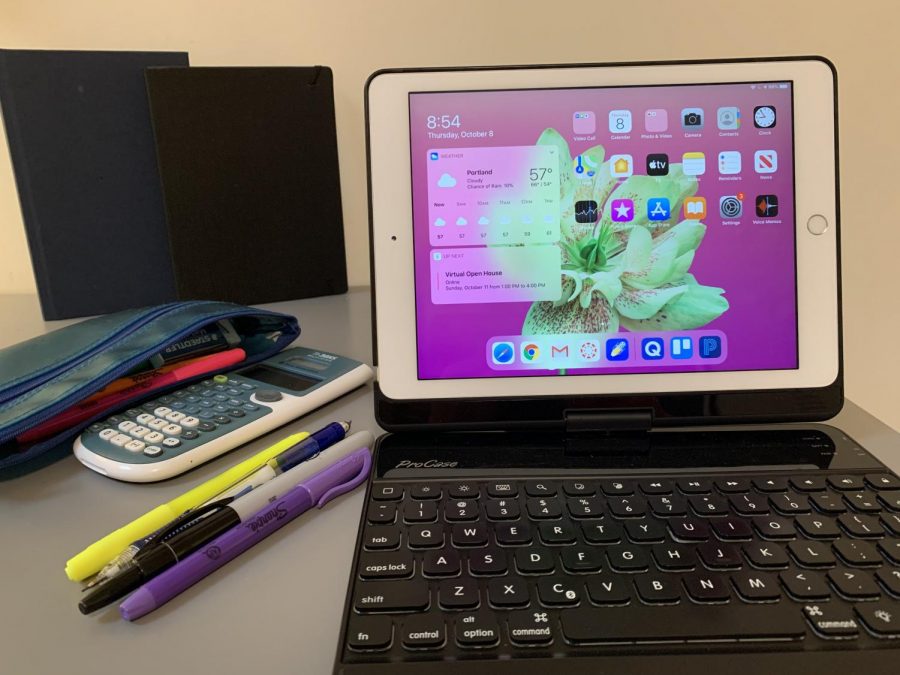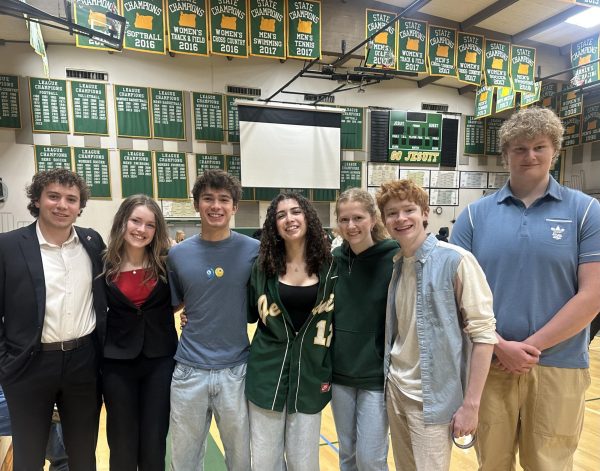Digital Learning: The Difference Between Synchronous and Asynchronous Learning
A student’s digital learning setup during distance synchronous learning at Jesuit High School.
With digital learning becoming the new reality for students due to COVID-19, administrators and teachers have developed new and innovative ways to conduct learning.
Online learning can be categorized into three learning styles: synchronous, asynchronous, and a hybrid of the two.
At Jesuit High School, digital learning for the 2020-2021 school year is partially synchronous with intermittent periods of asynchronous learning through Zoom calls. In the spring of 2020, however, asynchronous learning was enforced.
“When we talk about synchronous learning we are talking about activities that students are doing in real-time,” Alyssa Tormala, the vice principal of professional development and innovation at Jesuit, said. “It could consist of a class discussion over Zoom or online, as well as group projects as a class or in small groups.”
Asynchronous learning is taught without real-time interaction where assignments and instructions are posted online for students to work through.
According to TheBestSchools.org, asynchronous learning can take the form of pre-recorded videos, self-guided lessons, lecture notes, or online discussions.
Based on the feedback Jesuit collected during the spring, while some students enjoyed the flexibility of self-paced asynchronous work, the majority of students struggled with a lack of structure.
“There were students… struggling because they did not have that specific structure in the day to help them keep track with where they were and what they were doing in any given time,” Tormala said.
Other Portland area institutions, like Lincoln High School, are also online.
For Katlyn Kenney, a senior at Lincoln High School, her teachers’ material didn’t translate well through an online environment, which impacted her ability to retain information.
“I would rather have someone teaching and lecturing me, or showing me math problems to my face then giving me a worksheet to read,” Kenney said. “Watching a video a teacher made or watching a Khan Academy video just doesn’t really click.”
Without face-to-face interaction during asynchronous learning, student morale also decreased because of a lack of connection with peers and teachers.
“We got a lot of feedback from teachers and parents [saying] that they were missing the person-to-person contact,” Tormala said. “Students and parents reported that the lack of personal connection with classmates and teachers made students feel disconnected and isolated. Even though Zoom is not the same as being in-person, it still provides a level of connection that purely asynchronous learning did not.”
Because the asynchronous model wasn’t conducive to learning and mentally sustainable for students and teachers alike, Jesuit switched to a mainly synchronous model in the fall, consisting of three to four 80-minute zoom calls a day through a block schedule.
When asked about what led to the consensus on 80-minute Zoom calls, Tormala said it took a lot of research and communication with other schools nationwide and in the local Portland area.
“Most schools seemed to be moving toward that block schedule and 80 minutes appears to be the average,” Tormala said. “If you talk with other Catholic schools in the area, they are all using a similar structure of a block schedule of three to four classes a day somewhere between 65-85 minutes. So are many of our fellow Jesuit schools around the country.”
Throughout the 80 minutes provided for each class, whether or not students are required to stay on Zoom the entire period or break-off asynchronously is dependent on the teacher and subject they are teaching.
“If you as a teacher feel it’s important that students be in a synchronous learning situation, such as learning a new topic…where you want to keep everyone in the same sequence, you can use the 80 minutes for that,” Tormala said. “We trust our teachers to have good professional judgment about what the learning needs to look like at the point that they are in their unit and for a particular content area, and what their students are needing.”
Now six weeks into the school year, Jesuit has been gathering feedback from students, teachers, and parents on the new partially synchronous model.
“We all miss being in school with each other in person,” Tormala said. “But we have received deep gratitude from many of our students and our parents especially. We’ve had a lot of students say that they really like the block schedule as long as their teachers keep it interesting.”
Among the students at Jesuit who are embracing synchronous learning is junior Eli Flamoe.
“It has actually gone a lot smoother than I was expecting it to, and it feels more like real school,” Flamoe said.
Tormala commented that having 80-minute class periods “gives teachers more flexibility” and a “clear structure so they know what is happening on any given day.”
Despite the synchronous model promoting more interactive and structured learning, the challenge that remains is maintaining engagement while spending hours on Zoom.
“It’s just so much harder to pay attention online,” Flamoe said.
“I think everyone is feeling Zoom fatigue which is kind of to be expected and kind of unavoidable,” Tormala said. “Yet we have to encounter each other through this lens. It is the only way we can right now.”
There are many factors determining the success of synchronous or asynchronous learning with the main takeaway being that there will have to have a lot of trial and error before consistency and normalcy is established.
“With anything new it takes a while,” Tormala said. “Learning is a struggle no matter what it is that we are learning and right now we are learning how to engage in this environment on a regular basis. It will get easier because our brains will build new pathways to figure it out.”










